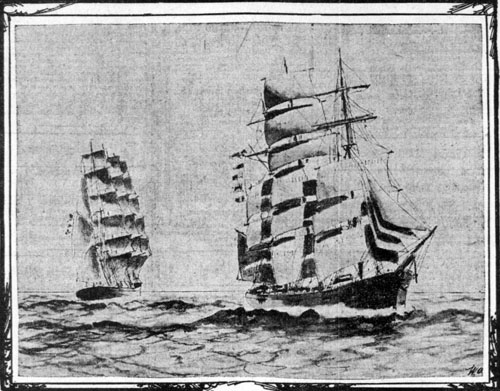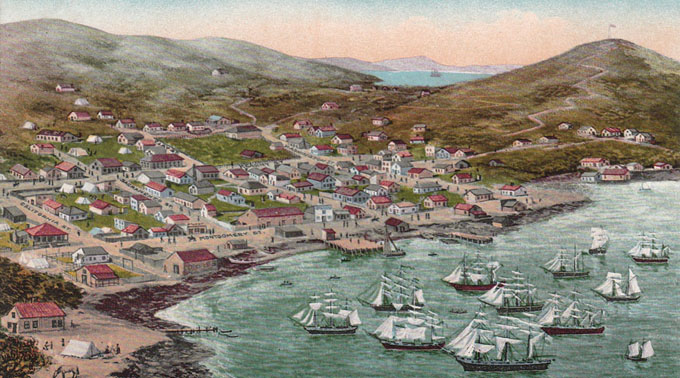Sea Captains: San Francisco 1800s
Duncan McLean
Duncan McLean, Master Mariner, captained the 19th century barques Ravenscourt and Earlscourt.
He sailed into San Francisco at least three times on the Ravenscourt between 1892 and 1896. His wife, Barbara (Orr), sailed with him on several voyages as did their three children.
His son, Duncan was the youngest, born 1884. Barbara Orr McLean's father, John Orr and her five brothers were all shipwrights who worked in the shipyards of Greenock, Scotland.
Her oldest brother, Archibald, worked on the Cutty Sark when she was fitted out in Greenock after launching in Dumbarton.
Barbara Orr McLean's oldest sister, Flora, married Hector MacLaine, also a shipwright. They immigrated to Alameda island in 1890 where Hector worked in the ship yard. Their address was 1200 Atlantic Blvd., Alameda Island. Their son, also named Hector, came over in 1891 and worked as a shipwright for the Union Iron Works in San Francisco. He later moved to Tacoma, Washington where he worked on the building of several ships.
May 3, 1892, San Francisco Call, San Francisco, California, U.S.A.
The British ship Earlscourt arrived yesterday after a fast run of 113 days from Liverpool. (Might be under Captain Lewis. Do not see Captain McLean on lists.)
Friday March 3, 1893, San Francisco Call, San Francisco, California, U.S.A.
British bark Ravenstown sailed, McLean, for Queenstown
May 29, 1895, San Francisco Call, San Francisco, California, U.S.A.
Shipping Intelligence
Several deep-waters came in yesterday, namely: the British ship Kelat, Kingsman, 147 days from Hamburg; the British ship James Kerr, Powles, seventy-three days from Newcastle NSW, 3506 tons coal to J. J. Moore & Co.; the British ship Halewood, Lonnen, 144 days from Antwerp, mdse to W. R. Grace & Co.; the British bark Ravenscourt, McLean, 244 days from Swansea, 23234 tons coal to J. D. Spreckels & Bros (the Ravenscourt sailed from Swansea on January 4, 1895 for San Francisco); the American brig J. D. Spreckels, Christiansen, twelve days from Honolulu (Kahului), 6350 bags sugar to Alexander & Baldwin.
August 11, 1896, San Francisco Call, San Francisco, California, U.S.A.
CITY NEWS IN BRIEF
The British bark Ravenscourt was the star attraction on the bay yesterday afternoon.She presented a very pretty appearance while her crew was unbending the sails after her long voyage from London.
September 16, 1896, San Francisco Call, San Francisco, California, U.S.A.
Burglary on a Bark.
Duncan McLean, captain of the bark Ravenscourt, swore to a complaint in Judge Joachimsen's court yesterday charging John McKewn, a sailor, with burglary. The captain alleged that McKewn broke into his cabin Monday afternoon and stole come clothing and other articles.
September 19, 1896, San Francisco Call, San Francisco, California, U.S.A.
F. F. McEwen, who was accused of stealing a quantity of clothing from the British shipRavenscourt, gave himself up yesterday at the Harbor Police station. The vessel is now on her way to Liverpool, so there will be no one to prosecute the case, and McEwen may get off. (Note: The Ravenscourt sailed for Queenstown, Captain McLean on Friday, September 18.)
July 8, 1902, San Francisco Call, San Francisco, California, U.S.A.
THREE OUT OF SIX OVERDUE SHIPS ARE CONSIDERED HOPELESS RISKS
Cumberland and Earlscourt, Coal Laden From Australia, are Added to the Reinsured Fleet
Small Hope Is Entertained for the Patterdale, Charlemagne and Brenn
THE British ships Cumberland and Earlscourt, both from Newcastle, Australia, and both laden with coal, were added yesterday to the overdue list. Upon the Cumberland, which is out 85 days for Taltal, reinsurance is quoted at 25 per cent. The Earlscourt, out 74 days for Valparaiso, is quoted at 15 per cent.

There are now six ships on the overdue list and the prospects seem poor for the arrival of at least three of them. The Patterdale, from Newcastle, Australia, for Valparaiso, is now out 106 days and is quoted at 90 per cent. Another 90 per center is the Charlemagne, out 203 days from Noumea for Havre. She is a new vessel of 1782 tons. Her chances of turning up are thought to be slim. TheBrenn, which has been on the board but a few days, was advanced yesterday to 30 per cent. She is bound here from Newcastle, England, and is out 184 days. The French bark Jane Guillon, which left Newcastle about the same time as the Brenn, arrived here June 24. The two vessels were in company in the Atlantic. They were separated in a sudden heavy storm, for which. Captain Clot of the Gullion says, the Brenn was ill prepared and which, in his opinion, she did not weather. The Crown of Scotland, out 167 days from Calcutta for this port, is quoted at 25 per cent.
July 15, 1902, San Francisco Call, San Francisco, California
Overdue Ship Arrives.
The British ship Earlscourt, which left Newcastle, Australia, for Valparaiso, eighty-four days ago and was on the reinsurance list at 20 per cent, reached her destination yesterday.

View of Golden Gate and Fort Point San Francisco, California
The Presidio has served as a military reservation from its establishment in 1776 as Spain's northern-most outpost of colonial power in the New World. It was one of the longest-garrisoned posts in the country and the oldest installation in the American West. In 1846, during the Mexican-American War, the 7th New York Volunteer Infantry Regiment occupied the crumbling adobes at the Presidio. The U.S. Regular Army took over the post the following year. This military reservation at the Golden Gate developed into the most important Army post on the Pacific Coast. Over time its armaments evolved from smooth bore cannons to modern missiles. It became the nerve center of a coastal defense system that eventually included Alcatraz and Angel Island and that reached as far north as the Marin Headlands and as far south as Fort Funston. Eventually, there were five distinct posts at the Presidio, each with its own commander: the Main Post, Fort Point, Letterman Hospital, Fort Winfield Scott, and Crissy Army Air Field. Also on the 1,491-acre reservation were a Coast Guard lifesaving station and a U.S. Public Health Service Hospital. From 1847 to about 1890, the Presidio defended San Francisco and also participated in the Indian Wars in the West. From the Spanish-American War of 1898 and the conquest of the Philippines to the end of the Vietnam War in 1973, the Presidio was a key link in the projection of American military power into the Pacific Basin and further west onto the mainland of Asia. New concrete fortifications built after the 1890s indirectly preserved native plant communities on the dramatic Pacific bluffs by making them off-limits.
The Authority to Sail: The History of U.S. Maritime Licenses and Seamen's Papers
Robert Stanley Bates, George Marsh (Editor), John F. Whiteley (Forward) (Batek Marine Publishing, 2011; Nominated in 2012 for a Pulitzer Prize)
This book depicts important aspects of our maritime history as a result of original research done by the author, Commodore Bates, the holder of an unlimited master's license who has enjoyed a distinguished fifty-year career in both the Coast Guard and the American Merchant Marine.
The U.S. Coast Guard issues all Captain Licenses for U.S. Ports.
Note: Other countries have different regulations, i.e. the RYA (Royal Yachting Association), conducts certification for Britain and Ireland. As of 2011, they did not recognize the USCG certification; certification through their courses was required.Master Unlimited is a licensed mariner in ultimate command of a vessel any gross tons. The captain is responsible for its safe and efficient operation, including cargo operations, navigation, crew management and ensuring that the vessel complies with local and international laws. All persons on board, including officers and crew, other shipboard staff members, passengers, guests and pilots, are under the captain's authority and are his or her ultimate responsibility. The STCW defines the Master as Person having command of the ship.
The Sea Chart
The Illustrated History of Nautical Maps and Navigational Charts
John Blake
The sea chart was one of the key tools by which ships of trade, transport and conquest navigated their course across the oceans. Herein is a history and development of the chart and the related nautical map, in both scientific and aesthetic terms, as a means of safe and accurate seaborne navigation. 150 color illustrations including the earliest charts of the Mediterranean made by 13th-century Italian merchant adventurers, as well as 18th-century charts that became strategic naval and commercial requirements and led to Cook's voyages in the Pacific, the search for the Northwest Passage, and races to the Arctic and Antarctic.
Get Your Captain's License. Fifth Edition
Charlie Wing
Considered the quickest, easiest, and least expensive way to prepare for the U.S. Coast Guard captain's ratings exams required for anyone who takes paying passengers on a boat, and useful for serious boaters who want to save money on insurance. 350 pages of seamanship and navigation tutorials. More than 1,500 questions and answers from the Coast Guard exams. Includes an interactive CD-ROM with all 14,000 questions and answers in the USCG database, so you can take an unlimited number of practice exams








 Copyright ~ 1998-2018.
Copyright ~ 1998-2018. 